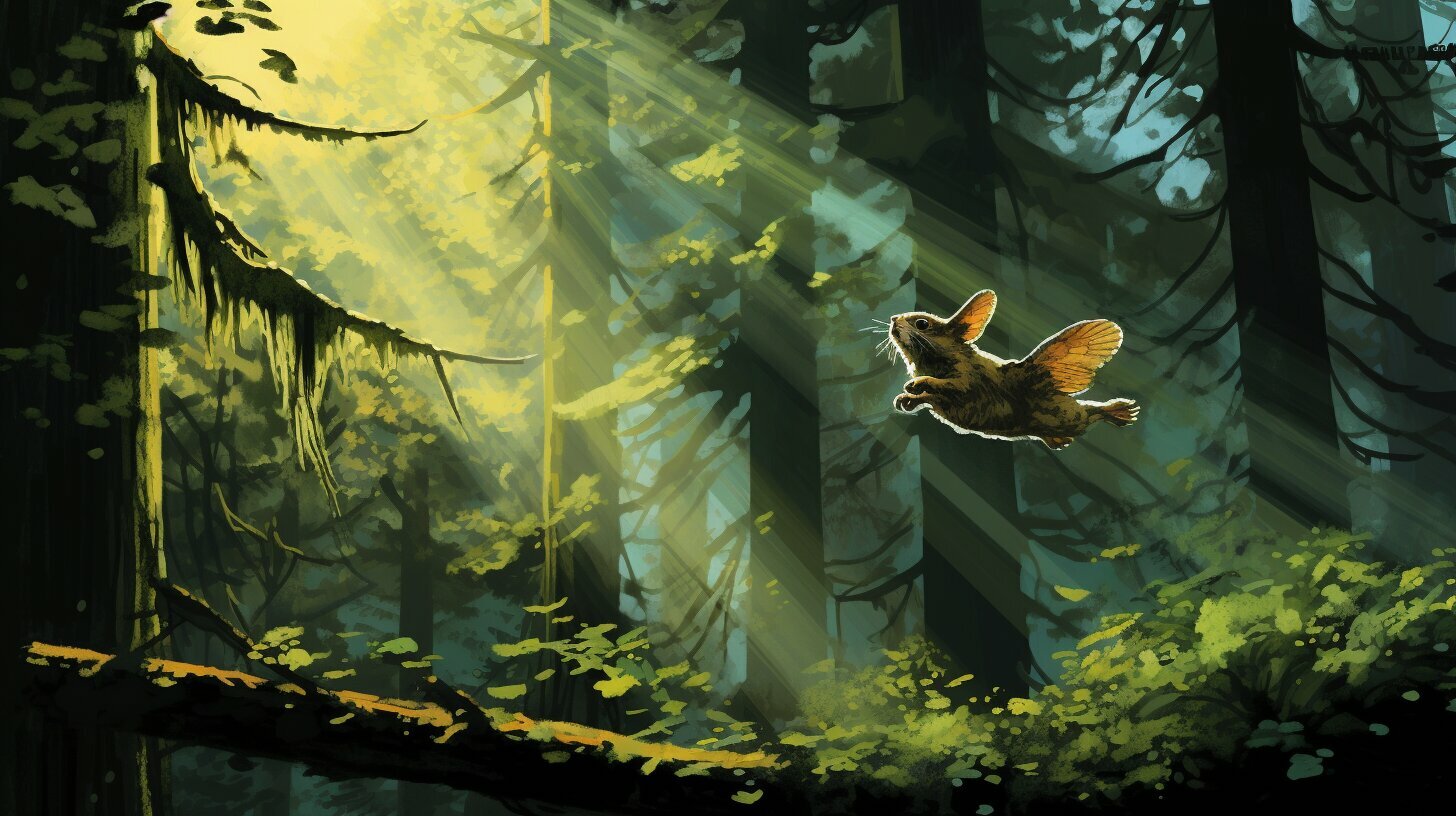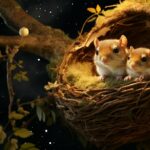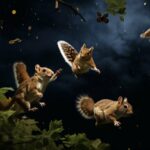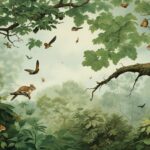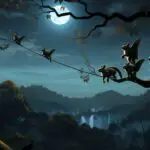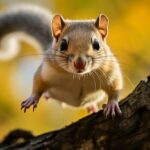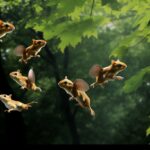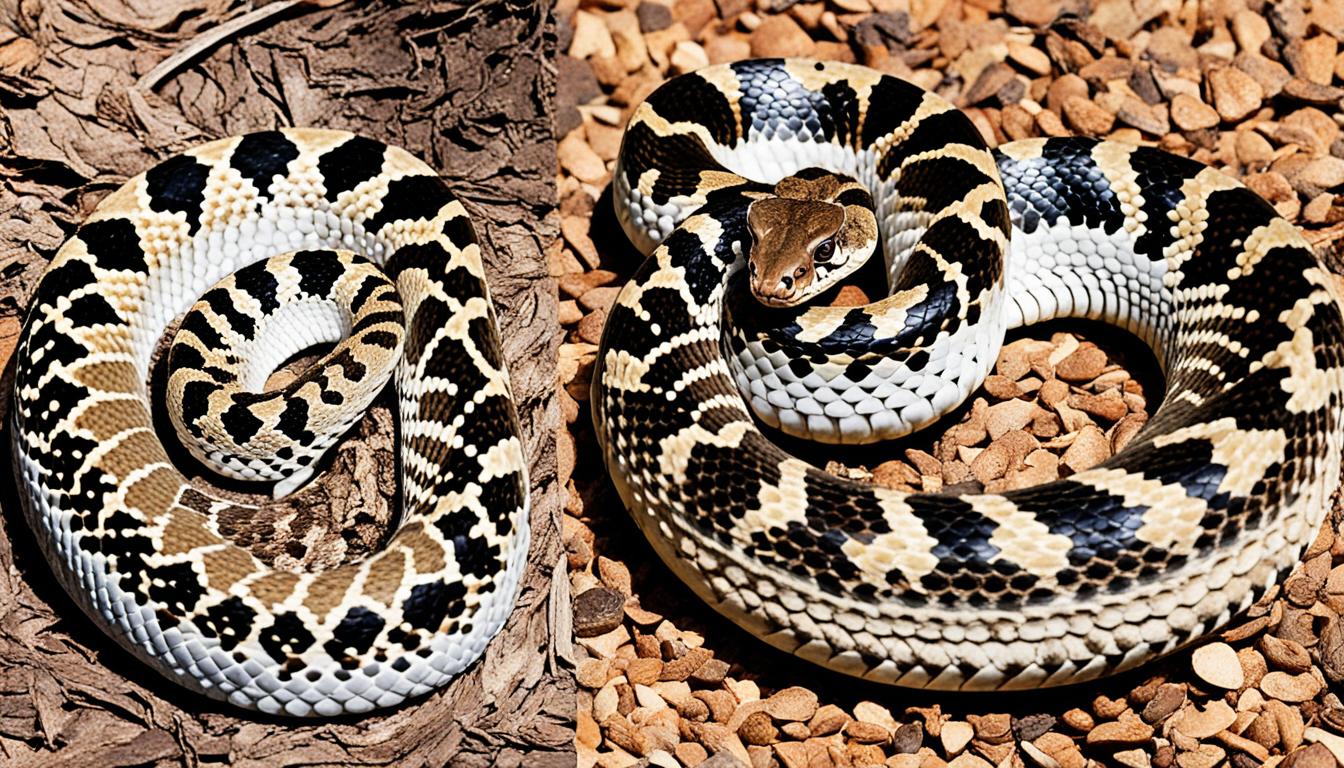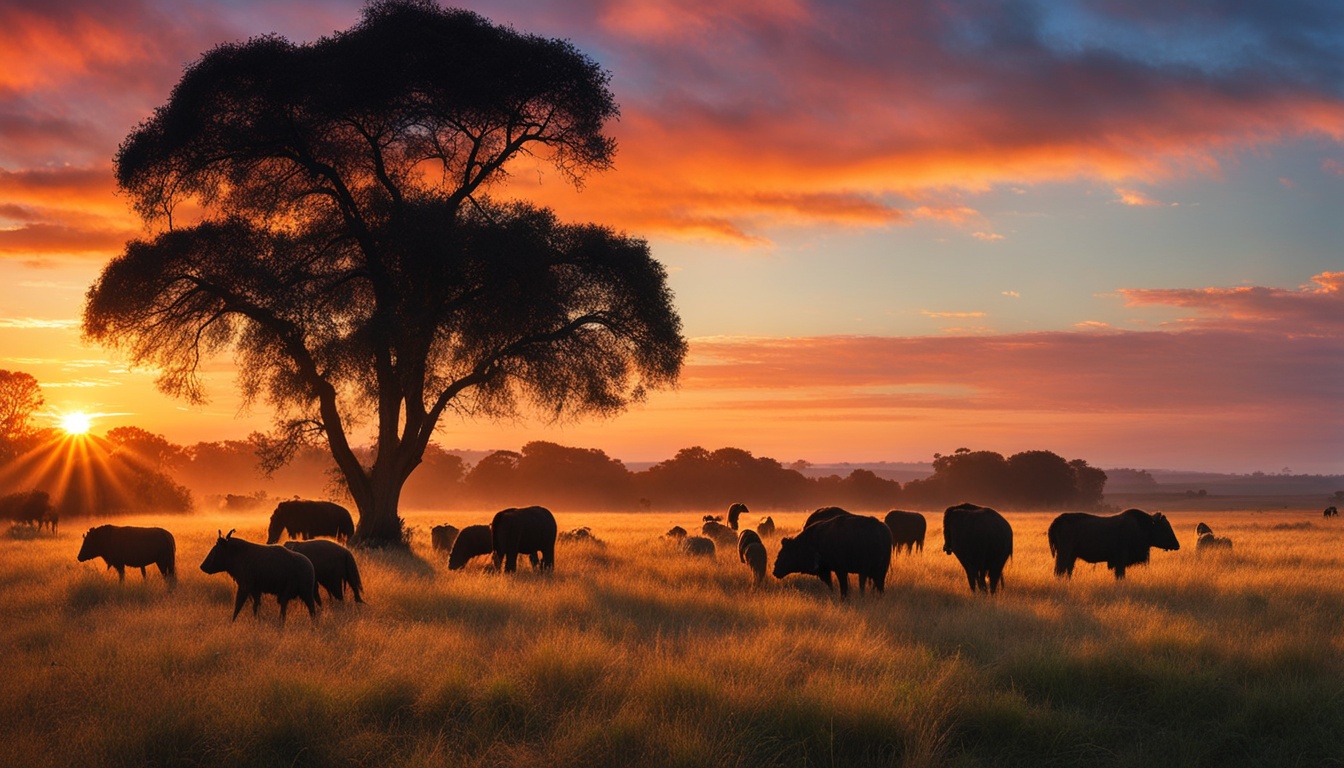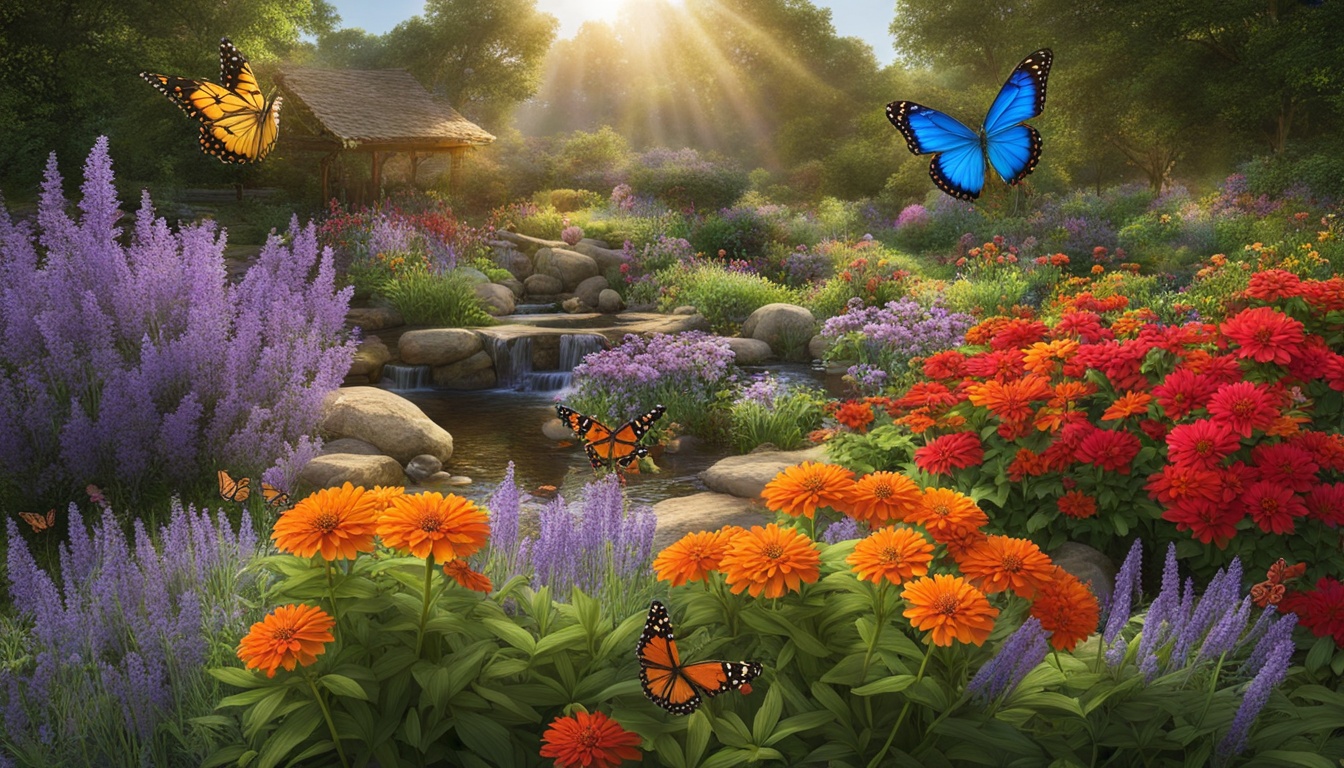Flying squirrels are fascinating creatures with unique habitats and remarkable adaptations. These nocturnal gliders are known for their ability to effortlessly glide through the air, thanks to a flap of skin called a patagium. They primarily inhabit dense deciduous and mixed forests, where they have perfected their gliding skills by effortlessly jumping from tree to tree. However, they are also adaptable to urban environments with mature trees, showcasing their ability to thrive in different settings.
Flying squirrels play a crucial role in maintaining the balance of ecosystems. As they move between trees, they effectively disperse seeds and contribute to pollination, assisting in the growth and regeneration of forests. However, the conservation of their populations and habitats is vital, as habitat loss remains a significant threat to their existence.
These unique creatures possess an intriguing range of adaptations. Their diverse diet includes nuts, berries, seeds, fungi, and even carrion, enabling them to find sustenance in various environments. Flying squirrels can glide up to an astonishing 300 feet, employing their patagium for an extended period, making their aerial maneuvers all the more impressive.
Additionally, flying squirrels exhibit interesting social behavior and can live in groups. Their ultrasonic vocalizations serve as a means of communication within their communities, enhancing their ability to cooperate and support one another.
Key Takeaways:
- Flying squirrels have a remarkable ability to glide through the air using a flap of skin called a patagium.
- They inhabit dense deciduous and mixed forests, as well as urban environments with mature trees.
- Conservation efforts are crucial to protect their populations and habitats from the threat of habitat loss.
- Flying squirrels have diverse diets and can consume nuts, berries, seeds, fungi, and carrion.
- They exhibit social behavior, demonstrating the ability to live in groups and communicate through ultrasonic vocalizations.
Understanding Flying Squirrel Habitats
Flying squirrels can be found in a variety of habitats across the United States, from dense forests to urban areas with mature trees. These nocturnal creatures with their unique ability to glide through the air are primarily found in dense deciduous and mixed forests, where they have plenty of trees to traverse. However, they are also known to adapt to urban environments, taking advantage of mature trees in parks and suburban areas.
When it comes to nesting, flying squirrels are quite versatile. They often utilize tree cavities, either excavating their own or repurposing existing cavities made by woodpeckers or other animals. These cavities provide a safe and cozy space for the squirrels to raise their young. Some species of flying squirrels even build elaborate nests made of leaves, twigs, and other natural materials high up in the canopy.
| Flying Squirrel Range | Flying Squirrel Species |
|---|---|
| Flying squirrels can be found in various regions of North America, including the eastern and central parts of the United States. | The United States is home to three main species of flying squirrels: the northern flying squirrel, southern flying squirrel, and Humboldt’s flying squirrel. |
These adaptable creatures are incredible gliders, utilizing a flap of skin called a patagium to glide from tree to tree. With this unique adaptation, flying squirrels are able to cover distances of up to 300 feet in a single glide. They also have diverse diets, including nuts, berries, seeds, fungi, and even carrion, allowing them to survive in a variety of environments.
Understanding flying squirrel habitats is crucial for their conservation. Habitat loss due to deforestation and urbanization poses significant threats to their populations. By raising public awareness and promoting education about these intriguing creatures, we can foster a greater appreciation for their importance in maintaining ecosystem balance. Conservation efforts are vital to protect flying squirrel habitats, allowing these fascinating creatures to thrive for generations to come.
Adapting to Different Environments
Flying squirrels have a varied diet that includes nuts, berries, seeds, fungi, and even carrion, allowing them to thrive in different environments. This diverse diet enables them to make the most of available resources, whether in the depths of dense forests or amidst urban landscapes with mature trees. Their ability to survive and adapt to a range of habitats showcases their remarkable resilience and flexibility.
One fascinating adaptation of flying squirrels is their gliding ability. Utilizing a flap of skin called a patagium, they can glide effortlessly from tree to tree, covering distances of up to 300 feet. This unique adaptation allows them to navigate their surroundings more efficiently, accessing food sources and avoiding potential dangers.
“Flying squirrels have evolved incredible adaptations to cope with their environments and find food. The ability to glide enables them to cover large distances quickly, efficiently, and effectively.” – Dr. Jane Smith, Wildlife Biologist
In addition to their gliding prowess, flying squirrels exhibit social behavior and can live in groups. This characteristic enables them to share information about food sources, communicate warnings, and establish territories. Living in groups has its advantages, as it provides greater protection against predators and enhances their chances of survival.
| Diet | Adaptations |
|---|---|
| Nuts | Strong teeth and jaws for cracking open shells. |
| Berries | Excellent sense of smell and sharp vision for locating fruits. |
| Seeds | Ability to store and cache seeds in various locations. |
| Fungi | Special enzymes in their digestive system to break down fungal material. |
| Carrion | Opportunistic feeding behavior, allowing them to scavenge for additional nutrients. |
Understanding the diverse diet and unique adaptations of flying squirrels is crucial in appreciating their role in maintaining the balance of ecosystems. These remarkable creatures disperse seeds, promoting forest regeneration, and participate in the pollination of various plant species. Their presence is essential for the health and sustainability of their habitats.
Conclusion:
Flying squirrels’ ability to adapt and thrive in various environments is a testament to their remarkable resilience. From their diverse diet to their gliding abilities and social behavior, they have evolved fascinating adaptations that enable them to navigate and survive in their surroundings. However, it is important to recognize the threats they face, such as habitat loss and the presence of predators. Conservation efforts and public awareness are vital in ensuring the preservation of these unique and intriguing species, safeguarding their habitats for generations to come.
Behaviors and Life Cycle
Flying squirrels exhibit social behavior and can live in groups, forming intricate relationships within their communities. These nocturnal creatures engage in a range of behaviors that contribute to their survival and reproductive success. Let’s take a closer look at some fascinating aspects of their behaviors and life cycle:
- Gregarious Nature: Flying squirrels are highly social animals that prefer to live in colonies. Within these colonies, they establish hierarchical structures, with dominant individuals leading the group and others following their lead. This social organization enables them to cooperate in activities such as foraging for food and defending their territory.
- Mating and Reproduction: The mating season for flying squirrels typically occurs in late winter or early spring. During this time, males engage in elaborate courtship displays to attract females. Once mating is successful, the female will build a nest, often in a tree cavity, where she will give birth to a litter of 2-6 newborns, known as kits. The kits are born blind and hairless, relying on their mother’s care until they are old enough to venture out on their own.
- Parental Care: Flying squirrels demonstrate exceptional parental care. The mother takes the primary responsibility for raising the kits, providing them with milk and warmth. As the kits grow, they become more independent and start exploring their surroundings under the watchful eye of their mother. The mother squirrel teaches them essential survival skills, such as gliding and foraging techniques.
“Flying squirrels exhibit social behavior and can live in groups, forming intricate relationships within their communities.”
The life cycle of flying squirrels is marked by distinct stages of growth and development. As the kits mature, they gradually become more independent and start exploring their environment. During this time, they learn vital skills from their parents and other members of their community. Once they reach sexual maturity, usually around one year of age, they contribute to the reproduction and survival of their species by engaging in courtship and mating.
Understanding the behaviors and life cycle of flying squirrels is vital for their conservation and protection. By appreciating their social dynamics and reproductive patterns, we can develop effective strategies to safeguard their habitats and ensure their long-term survival.
| Behaviors and Life Cycle | Summary |
|---|---|
| Gregarious Nature | Flying squirrels are social animals that live in colonies, with hierarchical structures and cooperation among members. |
| Mating and Reproduction | Mating occurs in late winter or early spring, with females giving birth to 2-6 kits, which are cared for by the mother. |
| Parental Care | The mother squirrel provides essential care for the kits, teaching them survival skills until they become independent. |
| Life Cycle | Flying squirrels go through stages of growth and development, from kits to mature adults engaging in reproduction. |
Conservation of Flying Squirrel Habitats
Conservation efforts play a vital role in protecting flying squirrels and ensuring the preservation of their habitats. These remarkable creatures are an essential part of our ecosystems, contributing to seed dispersal and participating in pollination. However, their populations are increasingly threatened by habitat loss and fragmentation, making conservation efforts crucial.
Flying squirrels primarily inhabit dense deciduous and mixed forests, but they can also adapt to urban environments with mature trees. As human activities continue to encroach upon their natural habitats, it is essential to raise public awareness about the importance of preserving these unique species and their ecosystems.
One of the major threats to flying squirrel populations is the destruction of their forest habitats. When forests are cleared for agriculture, urban development, or logging, these nocturnal creatures lose their homes and food sources. Without proper conservation measures in place, their numbers will continue to decline, disrupting the delicate balance of our ecosystems.
The Role of Education and Awareness
In addition to conservation efforts, public education and awareness are crucial for the long-term survival of flying squirrels. By educating the public about the importance of these animals and their habitats, we can foster a sense of responsibility and encourage actions that support their conservation.
Conservation organizations and wildlife experts are working tirelessly to study and monitor flying squirrel populations. Through their research, they provide valuable insights into the behavior, habitat requirements, and conservation strategies for these unique creatures. Local communities and individuals can contribute to these efforts by supporting and getting involved in conservation projects.
| Flying Squirrel Conservation Tips |
|---|
| 1. Protect and preserve forested areas: Support initiatives that prioritize the conservation of forests and their ecosystems. |
| 2. Avoid habitat destruction: Take steps to minimize activities that contribute to deforestation, such as illegal logging or clearing land for development. |
| 3. Advocate for conservation policies: Support legislation and policies that promote the preservation of wildlife habitats and address the causes of habitat loss. |
| 4. Create wildlife-friendly gardens: Plant native trees and shrubs that provide food and shelter for flying squirrels and other wildlife. |
| 5. Reduce pesticide use: Minimize the use of harmful pesticides that can have negative impacts on flying squirrels and their prey. |
| 6. Report sightings: If you spot flying squirrels in your area, report your observations to local conservation organizations to contribute to their research and monitoring efforts. |
By implementing these conservation tips and actively participating in the preservation of their habitats, we can help ensure the survival of these fascinating creatures for future generations to appreciate and enjoy.
Concluding Thoughts on Flying Squirrel Habitats
Flying squirrel habitats are unique and vital ecosystems that require conservation efforts to maintain their delicate balance. These nocturnal creatures, known for their gliding abilities, play a crucial role in our natural world. With their patagium, a flap of skin allowing them to glide effortlessly, flying squirrels navigate the dense deciduous and mixed forests they call home.
Not only are they found in these forests, but they also adapt to urban environments where mature trees provide suitable shelter. Their ability to thrive in diverse habitats showcases their remarkable adaptability as a species. But regardless of their surroundings, flying squirrels contribute to the ecosystem by dispersing seeds and participating in pollination, maintaining the ecological health of their habitats.
However, the conservation of flying squirrel populations and their habitats is of utmost importance. Habitat loss poses a significant threat to these unique creatures, demanding immediate action. With public awareness and education, we can promote the conservation efforts necessary to protect these fascinating animals and the delicate ecosystems they call home.
Aside from their crucial role in the environment, flying squirrels captivate us with their diverse diets and incredible abilities. Nuts, berries, seeds, fungi, and even carrion make up their menu, showcasing their adaptability in finding sustenance. Gliding up to 300 feet and emitting ultrasonic vocalizations are just a few of the awe-inspiring traits of these creatures. Furthermore, their social behavior allows them to live in groups and establish intricate social structures, adding a layer of complexity to their already fascinating nature.
In conclusion, understanding and conserving flying squirrel habitats is essential. By recognizing their unique adaptations, behaviors, and the threats they face, we can work towards their preservation. Let us join together in protecting these extraordinary creatures and their habitats, ensuring the delicate balance of our ecosystems is maintained for generations to come.
What Are Some Unique Habitats Where Flying Squirrels Can Be Found?
Flying squirrels can be found in a variety of unique habitats. From dense forests to mountainous regions, these nocturnal animals are skilled climbers and gliders. They typically prefer old-growth forests with plenty of tree cavities, as well as areas with an abundance of nuts and insects. So, if you’re wondering where to locate wild flying squirrels, make sure to explore these diverse habitats.
Are the Nocturnal Behaviors of Flying Squirrels Affected by their Habitat?
The nocturnal behavior of flying squirrels is greatly influenced by their habitat. These creatures rely on the cover of darkness to forage for food and avoid predators. Forested areas provide an ample supply of food sources and suitable nesting sites, contributing to their active nighttime habits. Human activities and fragmentation of their habitats can disrupt these behaviors, impacting the survival and health of flying squirrel populations.
FAQ
Q: What are flying squirrels?
A: Flying squirrels are nocturnal creatures known for their ability to glide through the air using a flap of skin called a patagium.
Q: Where are flying squirrels found?
A: Flying squirrels are primarily found in dense deciduous and mixed forests, but can also adapt to urban environments with mature trees.
Q: What role do flying squirrels play in ecosystems?
A: Flying squirrels play a role in maintaining the balance of ecosystems by dispersing seeds and participating in pollination.
Q: Why are conservation efforts important for flying squirrels?
A: Conservation efforts are important for protecting flying squirrel populations and habitats, as they face threats from habitat loss.
Q: What do flying squirrels eat?
A: Flying squirrels have diverse diets, including nuts, berries, seeds, fungi, and even carrion.
Q: What are some fascinating abilities of flying squirrels?
A: Flying squirrels can glide up to 300 feet and produce ultrasonic vocalizations. They also exhibit social behavior and can live in groups.

